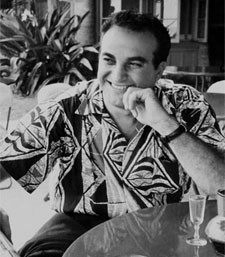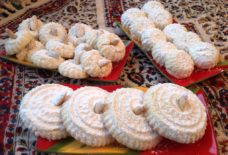Arab Americans
Alfred Shaheen

Alfred Shaheen (January 31, 1922 – December 22, 2008) was a textile industrialist who is credited with popularizing the Hawaiian shirt.
“Alfred Shaheen is arguably the father of the Hawaiian fashion industry. It was Shaheen who brought Hawai‘i fashion to the world. His unique and artful prints and sophisticated, fashion-forward silhouettes brought national, and even international, attention to island fashion from the 1940s through the 1980s. It was Shaheen who took aloha attire from casual tourist wear to elegant style statements.”
“He was a true visionary,” said Linda Arthur, a professor and curator for the Washington State University Department of Apparel, Merchandising, Design and Textiles. “He started in a place (Hawaii) where there was no industry to speak of and created one from the ground up, creating a truly vertically integrated business.”
“Island textiles icon Alfred Shaheen was among the founders of the modern Hawaiian garment industry, helping revolutionize the business not only through innovative designs but by establishing a business model that allowed him to introduce Hawaiian wear to people around the world.”
“No manufacturer inspires more respect than Alfred Shaheen, who built the most self-sufficient garment company Hawaii would ever see…. This success story of a family-run, Hawaiian owned and operated company has inspired others for more than 50 years.”
Elvis Presley wears the Tiare Tapa, an Alfred Shaheen shirt, on the album cover for his album Blue Hawaii.
Early life
Shaheen was born in Cranford, New Jersey on January 31, 1922 to a family of Lebanese immigrants, who were garment industry entrepreneurs. Shaheen’s grandfather, Assi Shaheen, came to the U.S. from Lebanon in the late-1800s and established silk factories in New York and New Jersey. Shaheen’s father, George, joined his father, Assi, in the U.S. in the early-1900s. George ultimately started his own business, Geo. Shaheen, with his wife, Mary. In 1938, George moved his family and his business to Hawaii, where George and Mary specialized in custom garments made from silks, brocades, rayon satin, and other formal fabrics. Alfred returned to the mainland to attend Whittier College, where he excelled at math, physics, engineering and football. Alfred graduated with a degree in aeronautical engineering just as the U.S. entered World War II. Alfred enlisted in the Army Air Corps and became a fighter pilot, flying 84 missions over Germany, Italy and France.
Surf ‘n Sand Hand Prints
In 1945, when Shaheen returned to Hawaii from the war, he joined his parents in their custom garment business. In 1948, in keeping with family tradition, Shaheen branched out to create his own garment company, specializing in ready-to-wear aloha shirts and women’s fashions. He started his company in the Shaheen family home on Kalakaua Avenue with four seamstresses trained by his mother, Mary. Like other Hawaiian manufacturers of his day, Shaheen’s aloha wear was originally made with textiles imported from the mainland. However, using these imported textiles had serious drawbacks. In the late-1940s, a dock strike and the Korean War severely curtailed importation of goods to Hawaii, and Shaheen soon realized that if he wanted to survive, he must find a way to create his own fabrics. Shaheen set up Surf ‘n Sand Hand Prints, his first print plant, in a Quonset hut on Hornet Street on the outskirts of town. With two inexperienced local workers, Shaheen began building his machinery from parts he found in Honolulu’s junkyards.
By 1950, Shaheen had engineered and built his own machinery to print, dye, and finish his fabrics. By 1952, Shaheen was printing more than 60,000 yards of fabric per month under the name Surf ‘n Sand Hand Prints. In 1956, Shaheen built an $8,000,000 factory, showroom, and office complex, and by 1959 Shaheen employed over 400 people, sold garments worldwide, owned his own chain of retail stores in Hawaii, and grossed more than $4,000,000 annually ($30,000,000 in today’s money). Shaheen attributes these achievements to Surf ‘n Sand and his ability to print and produce his own fabrics.
Master printer
Shaheen engineered his unique method of silk-screening textile designs for mass production, and introduced new sewing and production techniques to the garment industry. In his in-house training department, Shaheen and his mother, Mary, trained artists, printers, screeners, finishers, seamstresses, and models. These highly-trained individuals became known as Alfred Shaheen’s City of Craftsmen and produced the extraordinary garments that made Shaheen the largest aloha wear manufacturer in Hawaii in the 1950s and 1960s. These specialized craftspeople eventually integrated into the Hawaiian garment industry, taking with them the knowledge obtained from their training and experience.
Alfred Shaheen’s impact on the textile and apparel industry was not limited to Hawaii. Shaheen distributed his clothing all over the world and each garment was like a moving canvas. To Shaheen, textiles and apparel represented a mode of communication and his imagery honored all ethnic groups. Shaheen started the movement of using authentic cultural imagery in textiles and clothing, which brought ethnic themes to the forefront of the international apparel industry. Shaheen believed in celebrating our cultural diversity and insisted his artists create textile designs true to a culture’s roots. Shaheen prints were adapted from authentic sources, such as rare books found in libraries and ancient artifacts found in museums. Shaheen and his staff visited Tahiti, Samoa, Hong Kong and Tokyo to study the designs of the native Eastern Pacific Rim. Shaheen adapted these designs to textiles and produced such Hawaiian classics as the Pua Lani Pareau, Antique Tapa, and Joss Sticks handprints. Shaheen’s meticulous artwork and fashion sense established a sophisticated acceptance of exotic imagery in textiles and apparel. Although the phrase “East Meets West” is now part of our everyday language, Shaheen first used these words as the name of Shaheen boutiques established in the mid-1960s in major department stores across the country.
“He was a genius,” Dale Hope, creative director for Kahala Sportswear and author of the book The Aloha Shirt, told The Honolulu Advertiser. “Nobody came close to having the deep knowledge, and having the respect for the artists, the art, the printing, the distribution and the retailing. To be a vertical manufacturer — where you create your own art, make your own piece goods, sell them at your own retail stores and do wholesale accounts worldwide — that was pretty darn impressive.”
Shaheen’s designs were featured in the pages of fashion magazines such as Vogue, Mademoiselle, and Harper’s Bazaar. His clothes and fabrics were sold all over the world, including Bergdorf Goodman, Bloomingdale’s, Macy’s and Bullock’s.
In the 1960s, immediately following Hawaiian statehood, the company diversified, adding footwear, drapery, jewelry, fragrance, even pattern kits complete with fabric and coconut buttons.
Innovations
- Metallic Dyes. The Shaheen metallics were innovative metallic dyes for use in ready-to-wear clothing that were lightfast, chlorine- and saltwater-resistant, and could withstand the rigors of the tropics. Together with Dr. Edmund Lutz, his close friend and head dye chemist, Shaheen created over 100 metallic colors, including gold, silver, sapphire, ruby, and emerald. Sometimes the metallics would outline a print, and other times the metallics were used for the print itself. The metallics could be used on any washable fabric, and they have withstood the test of time—it has been over 50 years since the dyes were first created. Today we take metallic printing for granted, but creating the metallics in the early-1950s was a major achievement.
- Engineered Print. “Shaheen pioneered the engineered print, a silk screen design that was coordinated with the silhouette from the earliest design stages so the print and style created a stunning garment. He built his own 24-inch silk screens in order to produce large design motifs.”
- Pop-Up Shop, Store-Within-A-Store Boutique. “Shaheen originated the pop-up shop concept by creating “East Meets West” store-within-a-store boutiques. These pre-fabricated, self-contained units could be shipped all across the United States and assembled inside major department stores.
Labels
Shaheen’s Hawaiian shirts, sarongs and sundresses are some of the most prized pieces in vintage Hawaiiana collections. Shaheen’s Hawaiian labels include Alfred Shaheen, Shaheen’s of Honolulu, Surf ‘n Sand, Kiilani and Burma Gold Handprints. In his day, Shaheen was the only Hawaiian manufacturer to print his own fabrics, and using these fabrics, he created clothing for other retailers throughout the country. Some of these retailers include Andrades, McInerny, Liberty House, Waltah Clarke, Speedo, and Stetson. Therefore, it isn’t unusual to come across double labels that include the names of others garment companies, or to find Shaheen’s name on the selvedge of material used by retailers to create their clothing. In addition, Shaheen licensed his prints for manufacture in European countries and one may find a reference to a Shaheen European license printed on selvedge of material.
Retirement and death
In 1988, after 40 years in business, Shaheen retired and closed his doors. On December 22, 2008, at the age of 86, Shaheen passed away due to complications from diabetes.
Legac
- “Alfred Shaheen was the cornerstone on which the Hawaiian fashion industry was built, and he was pivotal in its transition from small mom-and-pop businesses to a modern garment industry. In the late 1940s, a period of time when Hawai‘i was still an American territory but quite isolated from the U.S. mainland, the garment business produced less than one million dollars in sales (in 1947). With Shaheen’s lead, the industry grew to $15 million in sales. He revolutionized the industry by pioneering large-scale screen-printing, manufacturing, distribution, and vertical integration of a fashion business. Shaheen combined all facets of textile and garment creation under one roof, establishing a model for the evolution of the Hawaiian garment industry. In so doing, he brought the fledgling industry into what was then considered cutting-edge fashion industry practices.”
- “Alfred Shaheen introduced Hawaiian clothing to the people of the world and changed the global landscape of textiles, fashion, and design forever. His impact on Hawai‘i was recognized in 2001 when he was awarded Hawai‘i’s Ka ‘Ahu No‘eau Lifetime Achievement Award. In 2006, Shaheen was listed as one of the 150 most important influences in Hawai‘i. Shaheen’s legacy continues to have an impact on Hawaiian fashion and its designers now, in the 21st century. The Hawaiian fusion fashion Alfred Shaheen brought to the U.S. captured a sense of Hawai‘i’s ethnic uniqueness that is at the heart of the aloha spirit.”
- “Alfred Shaheen wed technological innovation to socially responsible business practices. He revitalized Pacific Island/Asian textile traditions to forge a fusion fashion design aesthetic now recognized worldwide as a visual marker – not only of a transnational Hawaiian culture – but of a West Coast “American” lifestyle that is informal, environmentally aware and multi-cultural.”
- “A whirl of vibrant colors, lines, images, and patterns. Breathtaking flair, sunny motifs, and “bombshell” sensations. Splendid aloha styles of the fifties and sixties. Weave these together with a new approach to design development and management practice within the Hawaiian garment industry and what results is the story of Alfred Shaheen, a man whose impact was more than most will ever recognize.”
- “Alfred Shaheen has been called “visionary,” a “genius” and a “pioneer”. He did many things, but most importantly he introduced Hawaiian clothing and ethnic textile design to the people of the world, and in doing so forever changed the global landscape of textiles, fashion and design.”
Museum exhibits
- Bishop Museum, November 10, 2012 – February 28, 2013
- Maui Arts & Cultural Center, September 4, 2011 – October 29, 2011
- Washington State University, April 7, 2011 – May 3, 2011
- Arab American National Museum, October 7, 2010 – March 13, 2011
- San Jose Museum of Quilts & Textiles, May 18, 2010 – August 8, 2010


